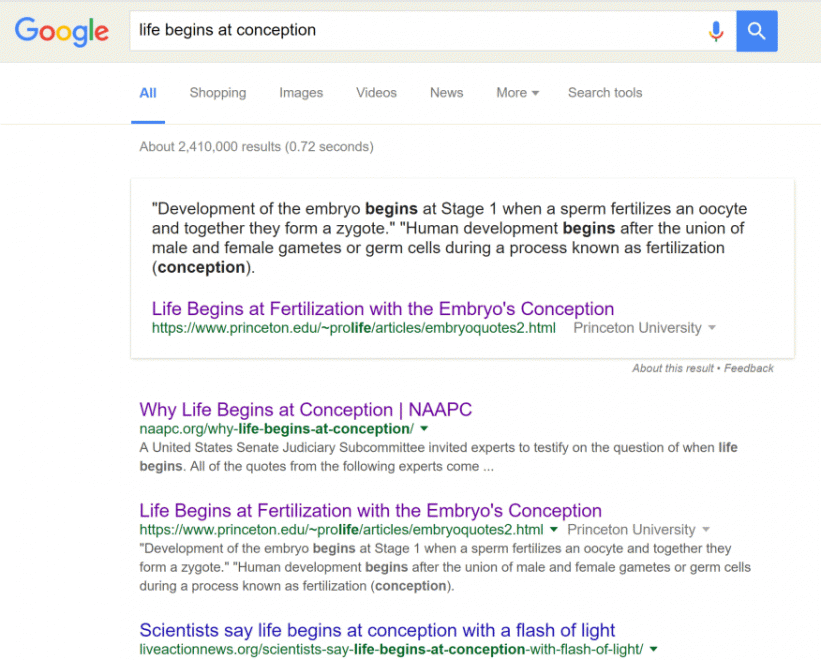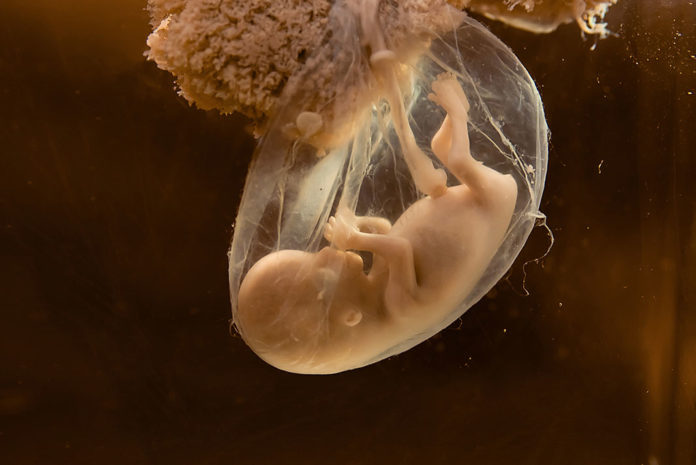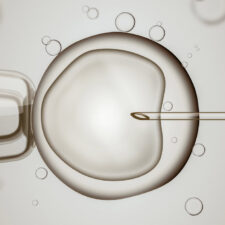Tonight, I heard a Jewish rabbi make the argument for a pro-choice stance in Reform Judaism. When I asked how they balance a pro-choice position against “Thou shalt not kill” she pointed to a semantic difference between murder and killing (according to the original Hebrew, she said.) She then alluded to a passage in the Torah regarding two men fighting and a pregnant bystander being hurt in the process. She said this story was proof that the unborn child was considered part of the mother—not an individual apart from the mother—because the value given in retribution was more akin to losing and arm or a leg; not capital punishment.
I looked this up when I returned home. Seems she was referring to Exodus 21:22-25 which pertains to Mosaic personal injury law. Here is the passage, from both the KJV and ESV and then finally from the Jewish Tanakh:
King James Version
“If men strive, and hurt a woman with child, so that her fruit depart from her, and yet no mischief follow: he shall be surely punished, according as the woman’s husband will lay upon him; and he shall pay as the judges determine. And if any mischief follow, then thou shalt give life for life, Eye for eye, tooth for tooth, hand for hand, foot for foot, Burning for burning, wound for wound, stripe for stripe.”
English Standard Version
“When men strive together and hit a pregnant woman, so that her children come out, but there is no harm, the one who hit her shall surely be fined, as the woman’s husband shall impose on him, and he shall pay as the judges determine. But if there is harm, then you shall pay life for life, eye for eye, tooth for tooth, hand for hand, foot for foot, burn for burn, wound for wound, stripe for stripe.”
As you can see, these two translations leave some question as to whether the child is included in the “life for life” retribution. The Jewish bible, however, seems to take things a bit further:
Jewish Tanakh (English)
“When men fight, and one of them pushes a pregnant woman and a miscarriage results, but no other damage ensues, the one responsible shall be fined according as the woman’s husband may exact from him, the payment to be based on reckoning. But if other damage ensues, the penalty shall be life for life, eye for eye, tooth for tooth, hand for hand, foot for foot, burn for burn, wound for wound, bruise for bruise.”
So I can understand why someone reading this latter translation would think this was a clear statement from God that the life of the unborn child didn’t matter as much as the adult’s. The rabbi likened the unborn child to an appendage and even said the child wasn’t considered a person until it was at least half-born (e.g. the child’s head and shoulders had emerged from the vaginal canal.) This is absolutely stunning to me. I marvel at the disconnected thinking it takes to arrive at the conclusion that a few inches and being on the wrong side of the mother’s womb should mean it’s okay to destroy what God has created.
I asked how she rectifies science having proven life begins at conception and she defensively claimed, “Science doesn’t claim that; religion does.”
I’ll admit, this was the first time I had ever heard this rebuttal. I had to do a little research to determine if this was the case. Turns out I didn’t have to look far. Her comment is utterly false. The first thing I found upon doing a search for “life begins at conception” (without quotes) looked like this:

From here I found two pages dedicated to examples whereby secular university textbooks seem to clearly state genetic uniqueness and specifically, that the resulting cell from the egg and sperm marks the “beginning of a new human being.” (Moore, 2003.) I’ve reproduced the contents of those pages below.
I’ll leave you to come to your own conclusions on this material. Personally, I believe God values us so much He sent His only Son to die for us (which I can’t even begin to wrap my head around.) I believe every life is of massive value to our heavenly Father. We are His work, after all.
For You formed my inward parts;
You covered me in my mother’s womb.
I will praise You, for I am fearfully and wonderfully made;
Marvelous are Your works,
And that my soul knows very well.
My frame was not hidden from You,
When I was made in secret,
And skillfully wrought in the lowest parts of the earth.
Your eyes saw my substance, being yet unformed.
And in Your book they all were written,
The days fashioned for me,
When as yet there were none of them.
Psalm 139:13-16 NKJV

Human Development
Assorted Quotes from Textbooks
The Developing Human Being
By Keith Moore, and T.V.N. Persaud
7th edition, 2003
From an introductory definition section:
“Human development is a continuous process that begins when an oocyte (ovum) from a female is fertilized by a sperm (spermatozoon) from a male. Cell division, cell migration, programmed cell death, differentiation, growth, and cell rearrangement transform the fertilized oocyte, a highly specialized, totipotent cell–a zygote–into a multicellular human being. Although most developmental changes occur during the embryonic and fetal periods, important changes occur during later periods of development: infancy, childhood, adolescence, and early adulthood. Development does not stop at birth. Important changes, in addition to growth, occur after birth (e.g., development of teeth and female breasts). The brain triples in weight between birth and 16 years; most developmental changes are completed by the age of 25. Although it is customary to divide human development into prenatal (before birth) and postnatal (after birth) periods, birth is merely a dramatic event during development resulting in a change in environment.” (p. 2)
“Zygote. This cell results from the union of an oocyte and a sperm during fertilization. A zygote is the beginning of a new human being (i.e., an embryo).” (p. 2)
“Embryo. The developing human during its early stages of development. The embryonic period extends to the end of the eighth week (56 days), by which time the beginnings of all major structures are present.” (p. 3)
From chapter 2: “The Beginning of Human Development: First Week”
First sentence of the chapter: “Human development begins at fertilization when a male gamete or sperm (spermatozoon) unites with a female gamete or oocyte (ovum) to form a single cell–a zygote. This highly specialized, totipotent cell marked the beginning of each of us as a unique individual.” (p. 16)
“Studies on early stages of development indicate that human oocytes are usually fertilized with 12 hours after ovulation. In vitro observations have shown that the oocyte cannot be fertilized after 24 hours and this it degenerates shortly thereafter.” [This would buttress our argument that sperm and ovum by themselves are parts of the parents and not entire beings. That there is a substantial change between gametes and zygotes.] (p. 31)
“The zygote is genetically unique because half of its chromosomes come from the mother and half from the father. The zygote contains a new combination of chromosomes that is different from that in the cells of either of the parents.” (p. 33)
“Cleavage consists of repeated mitotic divisions of the zygote, resulting in a rapid increase in the number of cells. The embryonic cells–blastomeres–become smaller with each cleavage division. First the zygote divides into two blastomores, which then divide into four blastomores, either blastomeres, and so on.” (p. 36-37) [We can use the cleavage discussion to show that now the embryo is operating on its own and developing.]
Human Embryology
William J. Larsen
3rd edition, 2001
“In this text, we begin our description of the developing human with the formation and differentiation of the male and female sex cells or gametes, which will unite at fertilization to initiate the embryonic development of a new individual” (p. 1)
“After the oocyte finishes meiosis, the paternal and maternal chromosomes come together, resulting in the formation of a zygote containing a single diploid nucleus. Embryonic development is considered to begin at this point. The newly formed embryo undergoes a series of cells divisions called cleavage as it travels down the oviduct toward the uterus. The cleavage divisions subdivide the zygote first into two cells, then into four, then into eight, and so on.” (p. 1-3)
Life Begins at Fertilization
The following references illustrate the fact that a new human embryo, the starting point for a human life, comes into existence with the formation of the one-celled zygote:
“Development of the embryo begins at Stage 1 when a sperm fertilizes an oocyte and together they form a zygote.”
[England, Marjorie A. Life Before Birth. 2nd ed. England: Mosby-Wolfe, 1996, p.31]
“Human development begins after the union of male and female gametes or germ cells during a process known as fertilization (conception).
“Fertilization is a sequence of events that begins with the contact of a sperm (spermatozoon) with a secondary oocyte (ovum) and ends with the fusion of their pronuclei (the haploid nuclei of the sperm and ovum) and the mingling of their chromosomes to form a new cell. This fertilized ovum, known as a zygote, is a large diploid cell that is the beginning, or primordium, of a human being.”
[Moore, Keith L. Essentials of Human Embryology. Toronto: B.C. Decker Inc, 1988, p.2]
“Embryo: the developing organism from the time of fertilization until significant differentiation has occurred, when the organism becomes known as a fetus.”
[Cloning Human Beings. Report and Recommendations of the National Bioethics Advisory Commission. Rockville, MD: GPO, 1997, Appendix-2.]
“Embryo: An organism in the earliest stage of development; in a man, from the time of conception to the end of the second month in the uterus.”
[Dox, Ida G. et al. The Harper Collins Illustrated Medical Dictionary. New York: Harper Perennial, 1993, p. 146]
“Embryo: The early developing fertilized egg that is growing into another individual of the species. In man the term ’embryo’ is usually restricted to the period of development from fertilization until the end of the eighth week of pregnancy.”
[Walters, William and Singer, Peter (eds.). Test-Tube Babies. Melbourne: Oxford University Press, 1982, p. 160]
“Embryo: The developing individual between the union of the germ cells and the completion of the organs which characterize its body when it becomes a separate organism…. At the moment the sperm cell of the human male meets the ovum of the female and the union results in a fertilized ovum (zygote), a new life has begun…. The term embryo covers the several stages of early development from conception to the ninth or tenth week of life.”
[Considine, Douglas (ed.). Van Nostrand’s Scientific Encyclopedia. 5th edition. New York: Van Nostrand Reinhold Company, 1976, p. 943]
“I would say that among most scientists, the word ’embryo’ includes the time from after fertilization…”
[Dr. John Eppig, Senior Staff Scientist, Jackson Laboratory (Bar Harbor, Maine) and Member of the NIH Human Embryo Research Panel — Panel Transcript, February 2, 1994, p. 31]
“The development of a human being begins with fertilization, a process by which two highly specialized cells, the spermatozoon from the male and the oocyte from the female, unite to give rise to a new organism, the zygote.”
[Langman, Jan. Medical Embryology. 3rd edition. Baltimore: Williams and Wilkins, 1975, p. 3]
“The development of a human begins with fertilization, a process by which the spermatozoon from the male and the oocyte from the female unite to give rise to a new organism, the zygote.”
[Sadler, T.W. Langman’s Medical Embryology. 7th edition. Baltimore: Williams & Wilkins 1995, p. 3]
“Development begins with fertilization, the process by which the male gamete, the sperm, and the female gamete, the oocyte, unite to give rise to a zygote.”
[Sadler, T.W. Langman’s Medical Embryology. 9th edition. Baltimore: Williams & Wilkins 2004, p. 3]
“The results of fertilization are (a) restoration of the diploid number of chromosomes, (b) determination of chromosomal sex, and (c) initiation of cleavage.”
[Sadler, T.W. Langman’s Medical Embryology. 9th edition. Baltimore: Williams & Wilkins 2004, p. 48]
“The question came up of what is an embryo, when does an embryo exist, when does it occur. I think, as you know, that in development, life is a continuum…. But I think one of the useful definitions that has come out, especially from Germany, has been the stage at which these two nuclei [from sperm and egg] come together and the membranes between the two break down.”
[Jonathan Van Blerkom of University of Colorado, expert witness on human embryology before the NIH Human Embryo Research Panel — Panel Transcript, February 2, 1994, p. 63]
“Zygote. This cell, formed by the union of an ovum and a sperm (Gr. zyg tos, yoked together), represents the beginning of a human being. The common expression ‘fertilized ovum’ refers to the zygote.”
[Moore, Keith L. and Persaud, T.V.N. Before We Are Born: Essentials of Embryology and Birth Defects. 4th edition. Philadelphia: W.B. Saunders Company, 1993, p. 1]
“The chromosomes of the oocyte and sperm are…respectively enclosed within female and male pronuclei. These pronuclei fuse with each other to produce the single, diploid, 2N nucleus of the fertilized zygote. This moment of zygote formation may be taken as the beginning or zero time point of embryonic development.”
[Larsen, William J. Human Embryology. 2nd edition. New York: Churchill Livingstone, 1997, p. 17]
“Although life is a continuous process, fertilization is a critical landmark because, under ordinary circumstances, a new, genetically distinct human organism is thereby formed…. The combination of 23 chromosomes present in each pronucleus results in 46 chromosomes in the zygote. Thus the diploid number is restored and the embryonic genome is formed. The embryo now exists as a genetic unity.”
[O’Rahilly, Ronan and Müller, Fabiola. Human Embryology & Teratology. 2nd edition. New York: Wiley-Liss, 1996, pp. 8, 29. This textbook lists “pre-embryo” among “discarded and replaced terms” in modern embryology, describing it as “ill-defined and inaccurate” (p. 12}]
“Almost all higher animals start their lives from a single cell, the fertilized ovum (zygote)… The time of fertilization represents the starting point in the life history, or ontogeny, of the individual.”
[Carlson, Bruce M. Patten’s Foundations of Embryology. 6th edition. New York: McGraw-Hill, 1996, p. 3]
“[A]nimal biologists use the term embryo to describe the single cell stage, the two-cell stage, and all subsequent stages up until a time when recognizable humanlike limbs and facial features begin to appear between six to eight weeks after fertilization….
“[A] number of specialists working in the field of human reproduction have suggested that we stop using the word embryo to describe the developing entity that exists for the first two weeks after fertilization. In its place, they proposed the term pre-embryo….
“I’ll let you in on a secret. The term pre-embryo has been embraced wholeheartedly by IVF practitioners for reasons that are political, not scientific. The new term is used to provide the illusion that there is something profoundly different between what we nonmedical biologists still call a six-day-old embryo and what we and everyone else call a sixteen-day-old embryo.
“The term pre-embryo is useful in the political arena–where decisions are made about whether to allow early embryo (now called pre-embryo) experimentation–as well as in the confines of a doctor’s office, where it can be used to allay moral concerns that might be expressed by IVF patients. ‘Don’t worry,’ a doctor might say, ‘it’s only pre-embryos that we’re manipulating or freezing. They won’t turn into real human embryos until after we’ve put them back into your body.'”
[Silver, Lee M. Remaking Eden: Cloning and Beyond in a Brave New World. New York: Avon Books, 1997, p. 39]
References
Life Begins at Fertilization. Retrieved from https://www.princeton.edu/~prolife/articles/embryoquotes.html.
Human Development. Retrieved from https://www.princeton.edu/~prolife/articles/embryoquotes2.html.













